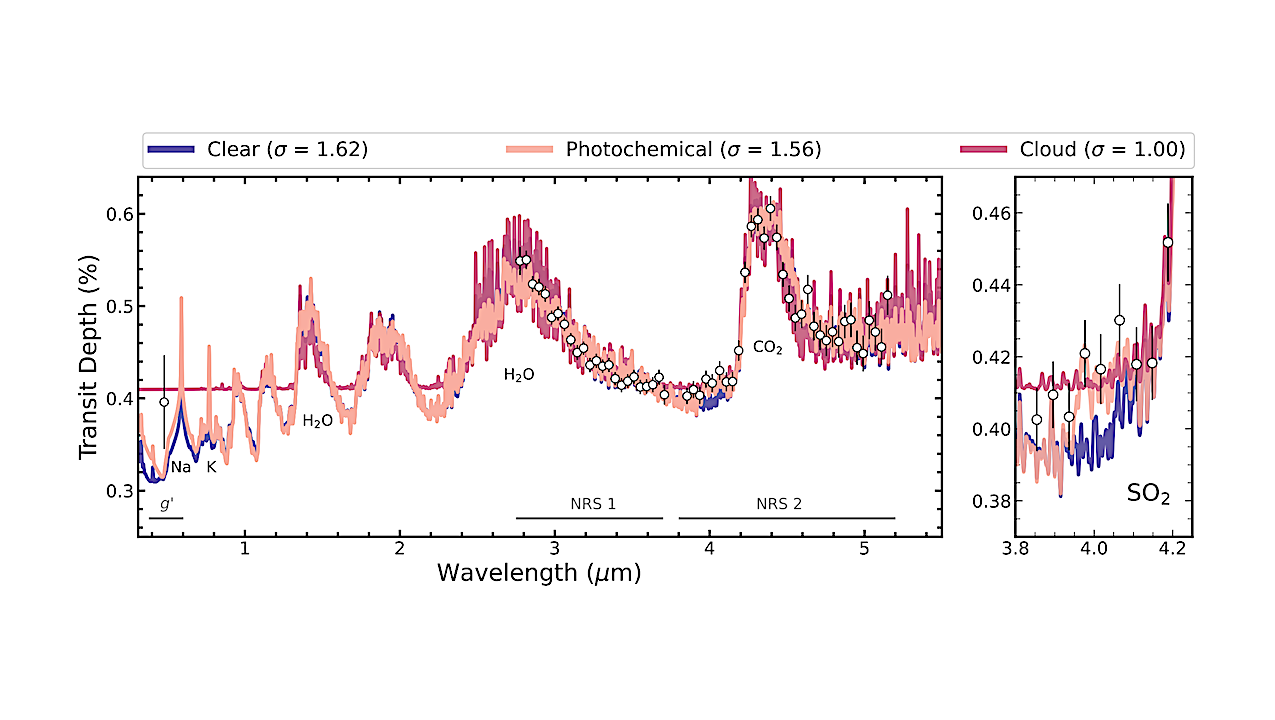The Featherweight Giant: Unraveling the Atmosphere of a 17 Myr Planet with JWST - Astrobiology (original) (raw)

Transmission spectrum of HIP 67522 b with the best (lowest sigma) atmospheric models for each scenario: for the clear atmosphere model, M = 15M⊕, C/O = 0.25, [M/H] = 1.5 (purple); for the cloudy model, M = 8M⊕, C/O = 0.25, [M/H] = 1.5 (pink); for the photochemical model, M = 15M⊕, C/O = 0.50, [M/H] = 1.0 (red). Models are binned to a spectral resolution of R=600 and data points are binned to a bin size of 4. The plot on the right highlights the presence of SO2 in the atmosphere of the planet. — astro-ph.EP
The characterization of young planets (< 300 Myr) is pivotal for understanding planet formation and evolution. We present the 3-5μm transmission spectrum of the 17 Myr, Jupiter-size (R ∼10R⊕) planet, HIP 67522 b, observed with JWST/NIRSpec/G395H.
To check for spot contamination, we obtain a simultaneous g-band transit with SOAR. The spectrum exhibits absorption features 30-50% deeper than the overall depth, far larger than expected from an equivalent mature planet, and suggests that HIP 67522 b’s mass is <20 M⊕ irrespective of cloud cover and stellar contamination. A Bayesian retrieval analysis returns a mass constraint of 13.8±1.0M⊕.
This challenges the previous classification of HIP 67522 b as a hot Jupiter and instead, positions it as a precursor to the more common sub-Neptunes. With a density of <0.10g/cm3, HIP 67522 b is one of the lowest density planets known.
We find strong absorption from H2O and CO2 (≥7σ), a modest detection of CO (3.5σ), and weak detections of H2S and SO2 (≃2σ). Comparisons with radiative-convective equilibrium models suggest supersolar atmospheric metallicities and solar-to-subsolar C/O ratios, with photochemistry further constraining the inferred atmospheric metallicity to 3×10 Solar due to the amplitude of the SO2 feature.
These results point to the formation of HIP 67522 b beyond the water snowline, where its envelope was polluted by icy pebbles and planetesimals. The planet is likely experiencing substantial mass loss (0.01-0.03 M⊕ Myr−1), sufficient for envelope destruction within a Gyr. This highlights the dramatic evolution occurring within the first 100 Myr of its existence.
Pa Chia Thao, Andrew W. Mann, Adina D. Feinstein, Peter Gao, Daniel Thorngren, Yoav Rotman, Luis Welbanks, Alexander Brown, Girish M. Duvvuri, Kevin France, Isabella Longo, Angeli Sandoval, P. Christian Schneider, David J. Wilson, Allison Youngblood, Andrew Vanderburg, Madyson G. Barber, Mackenna L. Wood, Natasha E. Batalha, Adam L. Kraus, Catriona Anne Murray, Elisabeth R. Newton, Aaron Rizzuto, Benjamin M. Tofflemire, Shang-Min Tsai, Jacob L. Bean, Zachory K. Berta-Thompson, Thomas M. Evans-Soma, Cynthia S. Froning, Eliza M.-R. Kempton, Yamila Miguel, J. Sebastian Pineda
Comments: Accepted for publication in The Astronomical Journal; 32 pages, 18 figures, 7 tables
Subjects: Earth and Planetary Astrophysics (astro-ph.EP)
Cite as: arXiv:2409.16355 [astro-ph.EP] (or arXiv:2409.16355v1 [astro-ph.EP] for this version)
https://doi.org/10.48550/arXiv.2409.16355
Focus to learn more
Submission history
From: Pa Chia Thao
[v1] Tue, 24 Sep 2024 18:00:02 UTC (5,564 KB)
https://arxiv.org/abs/2409.16355
Astrobiology